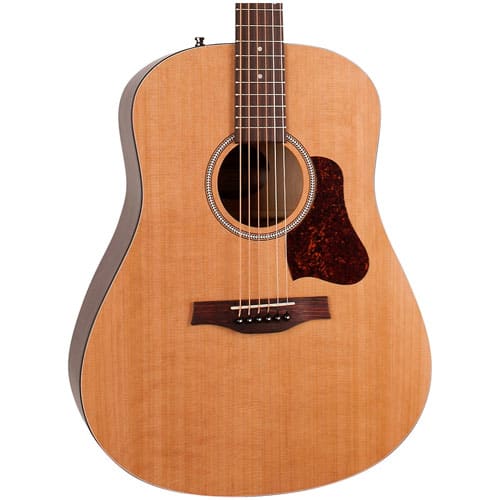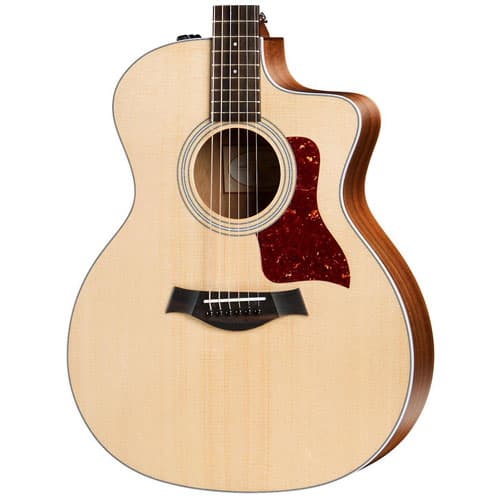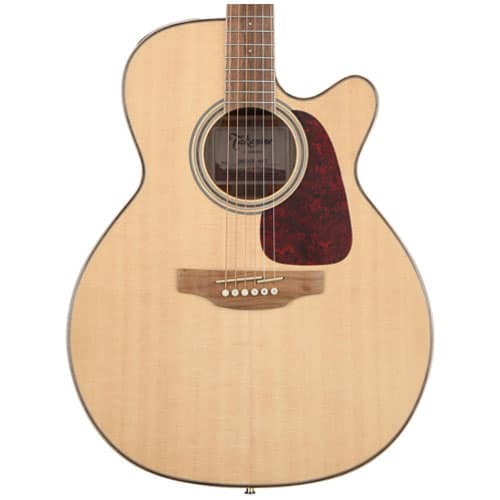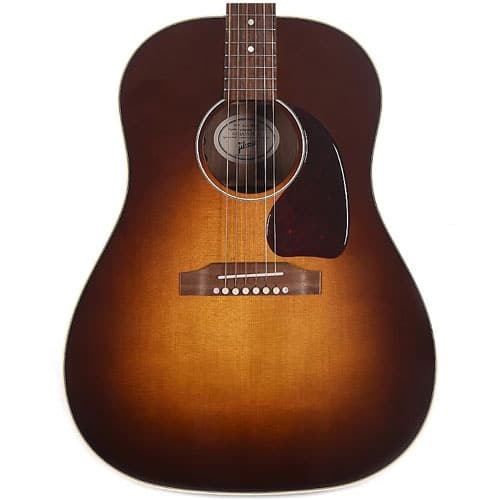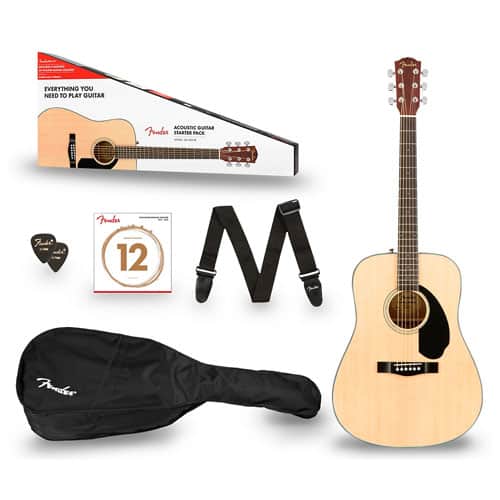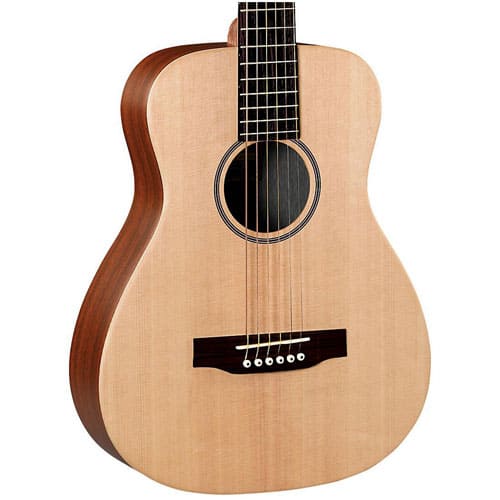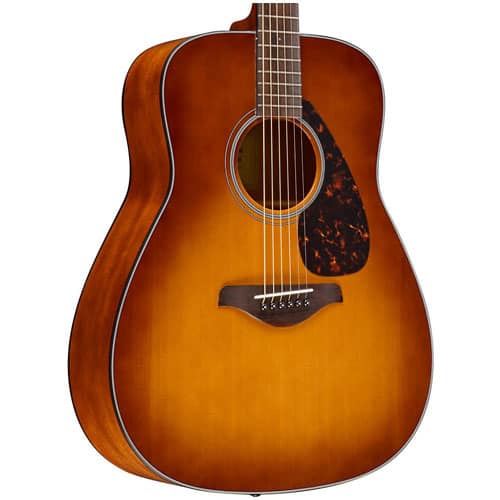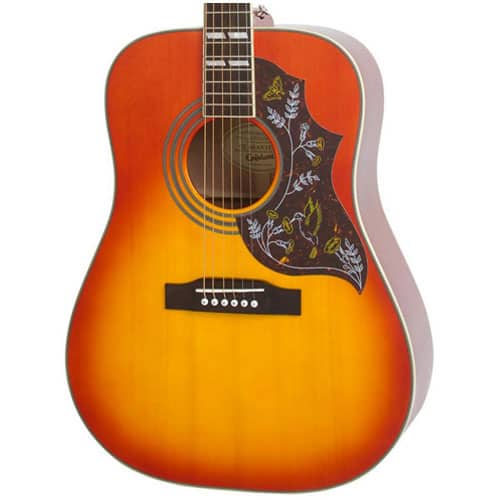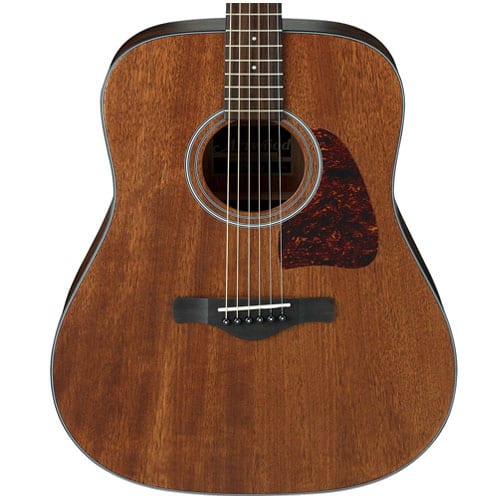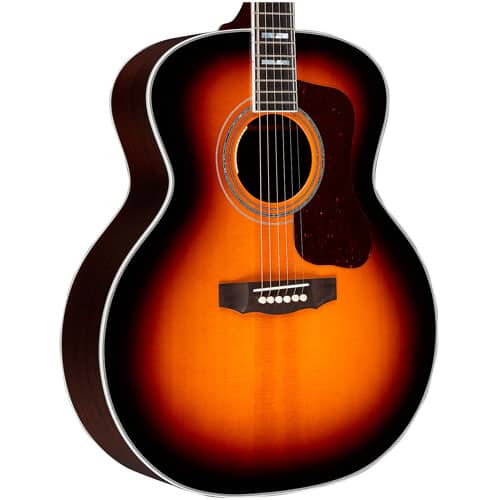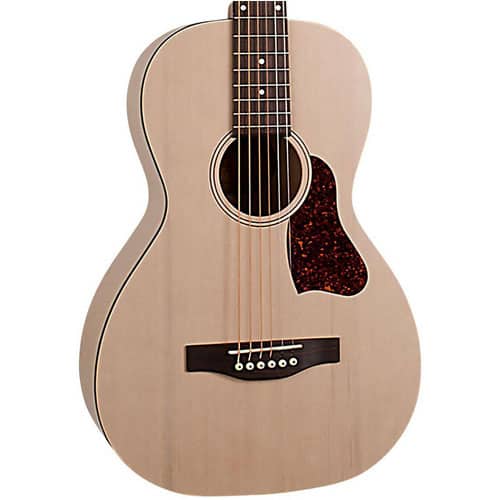Table of Contents
Whether you’re a first-time player or a longtime musician looking for an upgrade, finding the acoustic guitar that suits your playing style and preferences is no easy feat.
With literally hundreds of companies producing thousands of different guitars, determining the best acoustic brands can be a challenge.
That’s where we come in. We’ve explored the quality, features and design elements from a variety of companies to determine which acoustic guitar brands are worth your time.
Our No. 1 pick is Seagull. The Canadian company makes guitars that are accessible to beginners yet are also great for pros. Thanks to the combination of tonewoods and dynamic presence, Seagull guitars are perfect for almost any style of music.
If Seagull isn’t for you, there are 10 other great acoustic guitar brands worth your consideration. Read on to discover our picks for the best acoustic guitar brands — and find the one that will best suit your style and needs.
The 11 Best Acoustic Guitar Brands:
| Image | Guitar Brands | Summary | Check Price |
|---|---|---|---|
 | Seagull | Best Choice: Quality, durability and value combine for an amazing range of acoustic guitars on a budget | Check price |
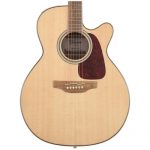 | Takamine | Best Value: Affordable brand that provides great value for playing in the studio and on stage | Check price |
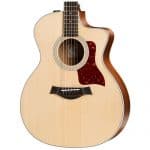 | Taylor | Premium Pick: Hand-built California guitars with top-notch tonewoods and original body shapes | Check price |
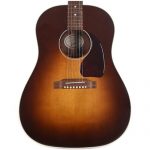 | Gibson | An Iconic, Top-Tier Manufacturer: Historic American brand that delivers iconic body shapes with hand-built quality | Check price |
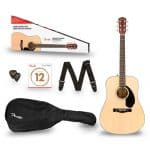 | Fender | Well-Known World Wide: Renowned globally for its entire product line, Fender’s guitars are known for their playability | Check price |
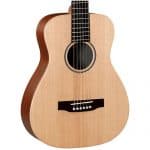 | Martin | Superb Craftsmanship As Standard: Definitive acoustic guitar brand with unparalleled legacy and build quality | Check price |
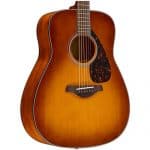 | Yamaha | Often Underrated But Actually Brilliant: Workhorse guitar brand that punches above its weight class | Check price |
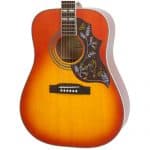 | Epiphone | Gibson Inspired: Affordable Gibson alternative that doesn’t compromise on quality | Check price |
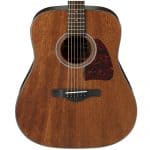 | Ibanez | One of the Global Giants: International brand renowned for quality and feel on a budget | Check price |
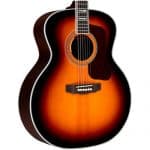 | Guild | Long-Standing Reputation: Legacy guitar brand with well-known premium acoustics | Check price |
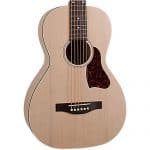 | Art & Lutherie | Exceptional Hand-Built Guitar Makers: Affordable handmade guitars with a vintage vibe | Check price |
Seagull
Seagull acoustics are known for their innovative design and sustainable tonewoods so it’s no surprise this Canadian company has become one of the best-known brands for beginner and intermediate players.
All Seagull guitars feature solid wood tops, built with a slight curve to improve resonance and durability. The slim headstock design keeps the strings in line from the nut to the tuners, for more accurate and stable tuning. Seagull builds all its guitars in Canada, so each instrument gets plenty of attention from experienced luthiers.
The S6 Original, Seagull’s flagship dreadnought, is the perfect example of the brand’s ethos. With a solid cedar top and wild cherry back and sides, it’s bold yet sustainable.
The silver leaf maple neck features a 1.75-inch nut width to encourage clear, precise string separation.
The smooth balance and loud projection make it perfect for strummers and singer-songwriters alike. The controlled bass and prominent mid-range help it cut through live mixes, which sounds great in the studio or on stage.
Positives
- Solid top and cherry bodies keep Seagull guitars sustainable
- Each guitar is hand-built in Canada for better quality control than most imports
Negatives
- Many Seagull models offer laminate bodies instead of solid wood
- Seagull headstock and decorations can be a bit bland

Takamine
Since the company’s founding in 1962, Takamine guitars have graced the stage with artists like the Eagles, Bruce Springsteen and Radiohead. They’re renowned for their outstanding electro-acoustic models, unique body shapes and creative ergonomic features — and that means they sound as good in the practice room as they do plugged in.
The smooth curves of Takamine body shapes like the NEX and FXC maximize acoustic projection without sacrificing clarity.
Takamines also feature asymmetrical necks, which are slightly thicker toward the bass strings and thin out as you reach the treble side. These contours are designed to fit your hands precisely and make it easier to slide up and down the neck.
The GN93CE offers those classic features, paired with a solid spruce top and walnut/maple back and sides.
With the volume of a dreadnought and the articulation of smaller models, it’s perfect for guitarists who need a precise and balanced instrument for any situation. It’s also got a TK-40D preamp, offering signature Takamine clarity when playing live.
Positives
- Best amplified acoustic sound on the market, even against brands like Martin and Fender
- Thoughtful design tweaks (like asymmetrical necks) offer a completely unique playing experience
Negatives
- Neck shapes might not be comfortable for all guitar players
- Better preamps drive up the cost of each guitar

Taylor
If you’re looking for a brand that combines premium tonewoods with dynamic voicing and pristine build quality, it’s hard to beat Taylor guitars. The California brand builds high-end acoustic guitars with lots of projection and top-end sparkle.
Taylor’s signature body shape, the grand auditorium, blends the strumming power of a dreadnought with the fingerstyle articulation of an orchestra or concert model.
You’ll also find innovative bracing shapes on many Taylor guitars, like V-shaped or fan bracing. These styles preserve projection while improving clarity and sustain for a more nuanced sound.
Out of Taylor’s lineup, the 214ce provides fantastic value for new and experienced players alike.
With a solid Sitka spruce top and layered rosewood back and sides, it’s a flexible acoustic guitar that can adapt to almost any style and the rounded cutaway keeps playing comfortable.
No matter what you play, the guitar maintains the bright, resonant top-end and smooth low-end that most Taylor guitars share. Taylor’s ES2 pickup system comes standard, so you also receive a great amplified tone.
Positives
- Dynamic voicing with brighter sound for clear, glassy tones
- Original body shapes offer crosses between existing models
Negatives
- Most affordable Taylor models use layered woods instead of solid bodies
- Not affordable for players on a tight budget

Gibson
Gibson is the rare guitar brand that’s as well known for its electric guitars as for its acoustics. Gibson guitars offer an unparalleled legacy, with classic designs that still sound fresh today.
Gibson produces some of the top dreadnoughts on the market, but the brand is also known for its jumbo acoustic guitars. These extra-large Gibson guitars sound loud and booming, with unmatched volume and sustain. With quality tonewoods like spruce, mahogany and maple, they’re some of the most resonant high-end acoustic guitars you’ll find anywhere.
Gibson is famous for its J45 slope-shoulder dreadnought model; a guitar that is not only a recording favorite, but one of the most celebrated acoustic designs of all time.
With a solid spruce top and mahogany body, it’s crisp and articulate for all genres. You get good projection because of the bigger body, but the slope-shoulder style keeps the tone focused and helps you cut through a mix perfectly. It’s the perfect choice for players who want one quality acoustic to do it all.
Positives
- Body shapes like the J45 and Jumbo are versatile for a wide range of styles
- Premium tonewoods ensure maximum resonance and shimmer in each guitar
Negatives
- A bit more expensive when compared to other guitar brands
- Gibson guitars often need a professional setup to get the best out of them

Fender
Fender’s legacy is linked to electric guitars, but the legendary brand also offers a diverse collection of acoustics. These models include both classic styles and more diverse shapes, so players in all genres can find a great fit.
Fender acoustic guitars prioritize playability and comfort, particularly in the brand’s smaller models. Standard features like rolled fretboard edges and modern C-shaped necks reflect the electric guitar heritage behind Fender.
Each Fender acoustic guitar is made to play fast and smooth, without the high action and tough strings associated with some of its competitors’ products. Tonewoods like mahogany, sapele, and spruce keep each Fender acoustic guitar smooth and crisp, with a tightly focused sound that cuts through live mixes.
The CD60Sv2 guitar pack offers Fender playability with versatile tonewoods at a low price. The solid top and scalloped bracing keep your tone supple and clear, while the walnut fingerboard offers rolled edges so it’s easy to grab chords up and down the neck.
Along with the guitar itself, this Fender pack includes accessories like a strap, strings and picks. Together, they help beginners get started and offer great value for a combination guitar pack.
Positives
- Comfortable features like rolled fretboards for long playing sessions
- Crisp tonewoods like mahogany keep your sound fresh and vibrant
Negatives
- Fewer premium models compared to other brands
- CD60Sv2 pack doesn’t include a hard-shell case

Martin
With more than 150 years of history, Martin is one of the preeminent acoustic guitar brands. Generations of players in all genres — from Johnny Cash to Paul McCartney to Johnny Marr — have cherished their Martin guitars because of their higher end craftsmanship and timeless sound.
Martin pioneered body shapes like the dreadnought and orchestra model (OM) and, even today, its model lines provide rich, supple response with a delicate mid-range and powerful bass.
The Martin dreadnought works great for strummers and flatpickers, while fingerstyle players appreciate the extra comfort and delicate phrasing of the Martin OM series.
Martin guitars often come with a higher price tag. If you want a Martin that delivers the brand’s classic performance in a comfortable, affordable package, the LX1 Little Martin is perfect.
Its shrunken dreadnought body is easy to play for long sessions, while the solid Sitka spruce top and mahogany back keep it focused and clear. As entry-level guitars go, it’s hard to beat the quality that Martin offers in this price range.
Positives
- 150-plus-year legacy makes Martin the preeminent acoustic guitar brand in America
- Inventors of the dreadnought and orchestra model body shapes
Negatives
- Some players might prefer tighter response instead of heavier Martin bass
- Very high price tags for new and intermediate players to access all-solid models

Yamaha
Yamaha’s acoustic guitars are known as workhorses for students and touring players. But beyond their resilient frame, many Yamahas offer unparalleled tone and build quality for their price range.
That value means Yamaha is among the best-known acoustic guitar brands for folk guitarists and singer-songwriters, even competing with Martin guitars in their high-end models.
At the budget end of the scale, this guitar brand is known for providing solid wood tops and loud, resonant bodies at very affordable prices. Yamaha is one of the few brands to offer scalloped bracing on its budget guitars, which improves both projection and tonal profile.
The FG800 guitar is one of the most famous models from the Yamaha brand. It channels the 50-year history of the “folk guitar” series, beloved by players in acoustic genres like country and rock.
The solid top puts the FG800 among the best acoustic guitars for beginners and students looking to pick up the instrument. The laminate mahogany body and scalloped bracing improve your articulation and clarity. The nut, meanwhile, measures 1.69 inches offering a compact and slinky feel.
Positives
- Amazing value across its entire budget line
- Solid tops and scalloped bracing provide better resonance than many more expensive brands
Negatives
- Some users report that tuners might need to be replaced
- Laminate bodies don’t offer as much natural resonance as solid bodies

Epiphone
While many people know that Epiphone produces Gibson-inspired guitars for beginners, the brand actually has a long and distinguished history of original acoustic guitar designs.
Players know Epiphone for their quality guitars and affordable pricing, making them one of the best acoustic guitar brands for entry-level and high-end designs alike.
Many modern Epiphone models provide the look and sound of Gibson guitars at a more reasonable price. Epiphone has tweaked acoustic guitar designs like the jumbo body shape and slope-shoulder dreadnought to make them their own.
You’ll also find plenty of Epiphones with solid tops and electronics built-in, which makes them perfect for playing in any situation.
If you want the best that Epiphone has to offer, make sure to check out the Hummingbird Pro. This dreadnought offers solid wood on top, with a mahogany body and stunning flamed finish. The block inlays and stylized pickguard are sure to turn some heads.
With Epiphone’s SlimTaper “D” neck, it’s comfy for strumming or fingerpicking. The included pickup and preamp lets you take the model on stage as well.
Positives
- Comfortable “SlimTaper ‘D’” neck is smooth and fast up and down fretboard
- Epiphone guitars offer Gibson style at a lower price
Negatives
- Electronic sets on Epiphones can add some artificial coloring to your sound
- Fit and finish doesn’t compare to Gibson models

Ibanez
Ibanez makes plenty of electric guitars, but the brand’s commitment to quality and value shines through in its acoustic guitar collection as well. Ibanez guitars are tough and durable, and they provide good sound quality for players on a budget.
On the acoustic market, Ibanez prioritizes traditional body shapes like the dreadnought and concert bodies. Most Ibanez acoustic guitars also use solid wood for the top so each guitar resonates smoothly. The Artcore series exemplifies these values and highlights the AW54OPN in particular.
The AW54OPN uses a solid top with a mahogany body. However, the top is made of solid mahogany coated in a beautiful open-pore finish. This all-mahogany design makes this one of the more unique acoustics on the budget market.
The open-pore finish delivers a unique feel that’s smooth and natural against your fingers. It’s a great alternative to thick gloss, and some players swear that it improves your tone as well.
Positives
- Classic, durable guitars that work well in all situations
- Solid tops maximize projection and sustain for players on tight budgets
Negatives
- Mostly laminate bodies, without a lot of solid wood
- Most Ibanez acoustic guitars follow established body shapes

Guild
Years ago, Guild competed with Fender and Gibson in both the acoustic and electric guitar markets. Nowadays the brand is known for its value-laden imports and higher-end American masterpieces. While it also offers an electric guitar division, Guild retains a pristine reputation in the acoustic guitar world.
Guild guitars often prioritize volume and clarity for a powerful yet controlled signature. High-end Guilds incorporate lots of premium design touches to set them apart from other brands in looks as well as sound.
Players particularly love Guild’s jumbo acoustics. The brand was one of the first to embrace this larger body shape, and its decades of expertise shines through in models like the F55E.
With a solid piece of spruce on top, these guitars project outstandingly well. You get the choice of rosewood or maple for the body, which changes the tonal character of the guitar. Acoustic resonance is more balanced with rosewood, with washy bass and lots of boom. Maple is tighter and more controlled for players who need to cut through a mix on stage.
Either way, you get Guild’s delicate bracing and nitrocellulose lacquer finish, which helps the top “breathe” and improves character over time.
Positives
- Jumbo body shape provides a powerful, loud response that’s not possible with most other brands.
- Maple bodies produce bright, clear sound that’s articulate for guitarists across genres
Negatives
- Price gap between imports and American-made models is severe
- Jumbo body is too large and unwieldy for some players

Art & Lutherie
Canadian acoustic guitar brand Art & Lutherie makes affordable acoustic guitars with a focus on sustainable tonewoods and hand-built quality. Its instruments channel plenty of retro flair, so the guitars look as distinctive as they sound.
As part of the Godin group of guitar brands (along with Seagull guitars), Art & Lutherie guitars are built by hand in Canada with local tonewoods. You’ll find solid cedar and spruce tops paired with wild cherry bodies for a dry, punchy signature that’s crisp and clear in any situation.
Most Art & Lutherie guitars offer retro finishes to go with their vintage-inspired styling. Whether you pick matte black, wine red or denim blue, these guitars are sure to turn heads.
The Roadhouse Parlor guitar is one of the company’s best-known models. With a curvy parlor body, this travel-sized guitar is perfect for songwriting and jamming. The silver leaf maple neck features a 1.72-inch nut, for a vintage-accurate feel and easy fretting.
The smaller sonic cavity focuses the sound on the mid-range and provides surprising projection for its size. That projection helps it stand out in a mix for studio recording or live dates.
Positives
- Retro look and feel set Art & Lutherie guitars apart from the pack
- Sustainable tonewoods lower price and provide fantastic sound
Negatives
- Body shape of flagship Parlor model might not be large enough for some players
- More expensive than some other budget acoustics, with electronics costing more on top

Which Guitar Brand Is Best?
It’s tough to establish one acoustic guitar brand as the “best.” However, there are a few brands that many players prefer above the rest. Over the history of the acoustic guitar, premium brands like Martin and Taylor have established themselves as many players’ favorites.
Guitarists love Martin because of the brand’s historical reputation and era-defining sound. The bassy rumble of a Martin dreadnought or delicate pluck of an orchestra model have been heard on countless records since its introduction.
As inventors of the dreadnought and orchestra (OM) body shapes, Martin is the best guitar brand for vintage, articulate sound with powerful bass response. Even today, Martin guitars remain the standard for lots of musicians in the studio and on tour.
Taylor, meanwhile, offers brighter acoustics with sparkling trebles. This modern twist gives them a more dynamic voice, with lots of range for different styles. The brand’s grand auditorium body shape falls between a dreadnought and an OM and it’s suited for either strumming or fingerpicking, depending on your style.
If you’re on a tight budget, it’s hard to beat the value of Yamaha or Seagull guitars. Players love these brands because they take the best components of body shapes from Martin or Taylor, and add thoughtful upgrades. Little tweaks, like a slimmer nut width or a slight curve to the top of the instrument, create a smoother feel for new players to explore.
Ultimately, the best acoustic guitar depends on your playing style and personal needs. In general, brands like Martin and Taylor produce incredible models for you to try. But, it’s important to consider your style before you spend money on a new guitar.
Hard-strumming players often gravitate towards dreadnoughts and jumbo models, which have more headroom for strummers. Lighter players often prefer OM-style guitars thanks to their articulation and touch.
Which Is The Best Brand Of Acoustic Guitar For A Beginner?
While there are plenty of fantastic acoustic guitars on the market today, beginners need some specific features to improve their playing. Aspects like comfort and playability are just as important as sound for many new players.
The top acoustics for beginners offer features like rolled fretboards and curvy body shapes to stay comfortable for long sessions. Some beginners prefer a more compact nut for easy chords, while others like a wider neck for fretting individual notes.
Features like a solid top and scalloped bracing are also extremely helpful for sound quality. Whether you’re a beginner or just on a beginner’s budget, your acoustic guitar should sound loud and punchy in all situations.
In these respects, a couple of brands stand out: Seagull, Fender and Yamaha. Seagull’s hand-built guitars don’t feature the pokey frets or iffy leveling of other brands built in massive workshops. This makes Seagull guitars easy to play straight out of the box, and keeps them resonant and lively.
Fender offers plenty of advanced playability features such as rolled fretboard edges and comfortable neck shapes. Fender guitars also come in plenty of different sizes, so any player can find a model that fits their body well.
For beginners, you can also find some Fender instrument packs. These sets include a Fender acoustic guitar with all the accessories you need to start playing. They’re a fantastic deal for any young player who loves Fender and wants an outstanding budget acoustic.
Yamaha has been a favorite choice for beginners for years. Its entry-level guitars maximize playability with a 1.69-inch nut width. Compared to common models measuring 1.72 or 1.75 inches, Yamaha guitars are easier for fretting chords.
Yamaha also scallops the bracing on its guitars, alongside brands like Fender and Martin. Together with its solid tops, you can jam to your hearts’ content or sharpen up your sound for live gigs.
What Is The Best Acoustic Guitar Of All Time?
The history of the acoustic guitar is so complex that it’s hard to pick just one guitar as the best of all time. There are a few guitar models, however, that have influenced players more than any others.
The Martin D28 pioneered the dreadnought body shape with loads of projection and a smooth, ample bass response. The combination of spruce and rosewood balances treble clarity with resonant bass and plenty of harmonic overtones.
It’s that rare combination of power and finesse that has made the D28 popular with players from Elvis Presley to John Lennon to Neil Young. It’s a versatile instrument that’s equally capable for strummers and fingerstyle players alike.
While the D28 set the template for decades, the Taylor 814ce revolutionized the acoustic guitar industry. Like the D28, it combines spruce and rosewood for clarity and warmth. It introduced Taylor’s signature “grand auditorium” body, mixing the power of a dreadnought with the touch of an orchestra or concert guitar.
That unique body shape made the 814ce a hit with players in all genres. Even today, it’s one of the most versatile acoustic guitars on the market, along with models from Martin and Fender.
The Gibson J45 is another iconic acoustic guitar that’s in the running for the “greatest ever” title. The sloped shoulders make it more comfortable and focused than a standard dreadnought. Gibson also cut down on acoustic cavity space, which gives the J45 a more direct, brash sound than traditional dreadnoughts.
That “up-front” sound made the J45 a classic tool for studio recordings. Perhaps that’s why it’s one of the most recorded guitar models in history. So, if you’re looking for the absolute top acoustic of all time, any of these models is a strong contender.
Bottom Line
Overall, we settled on Seagull as the top acoustic brand. Seagull blends value, build quality and attention to detail like few other brands on the market today.
If you want a step up, make sure to check out Martin and Taylor guitars. They’re two of the most storied builders in acoustic history, and their instruments live up to their hefty reputations.
What’s your favorite acoustic guitar brand? Are there any other guitars or brands you think we should add to this list? Let us know in the comments below.
